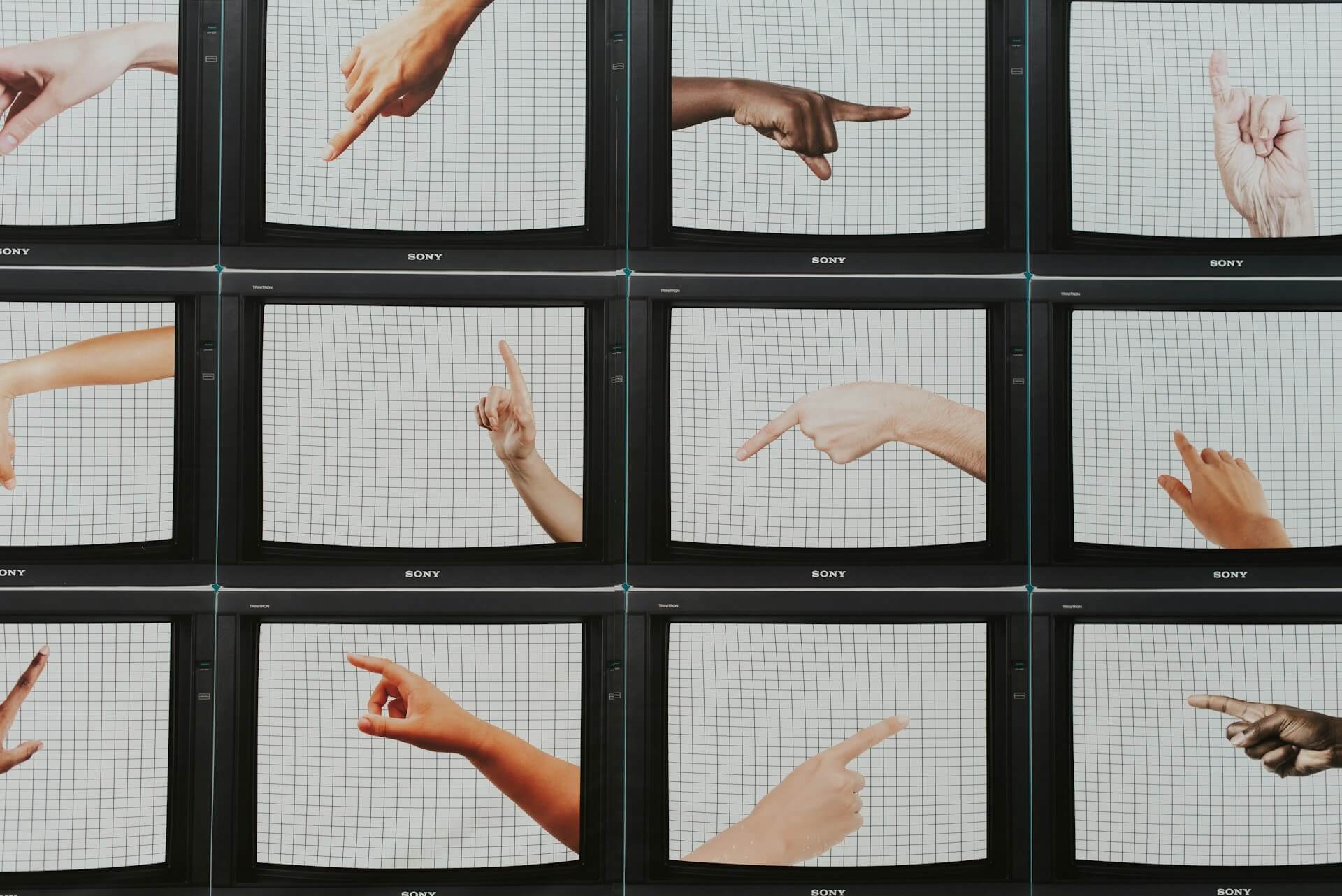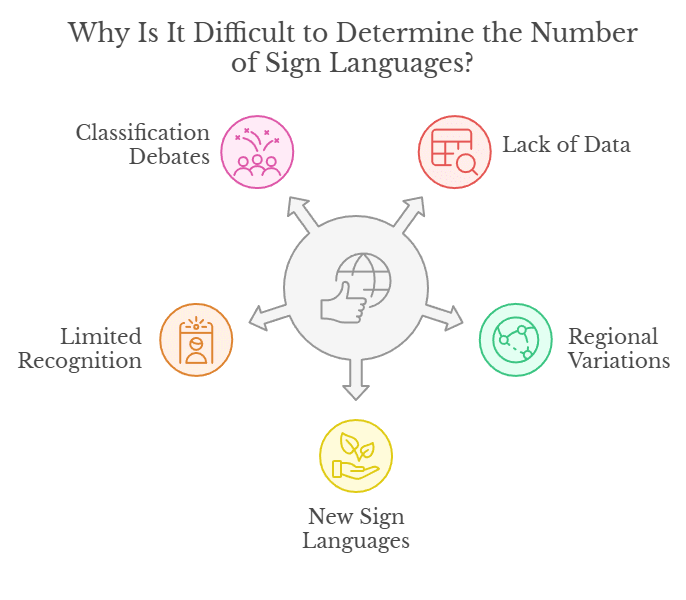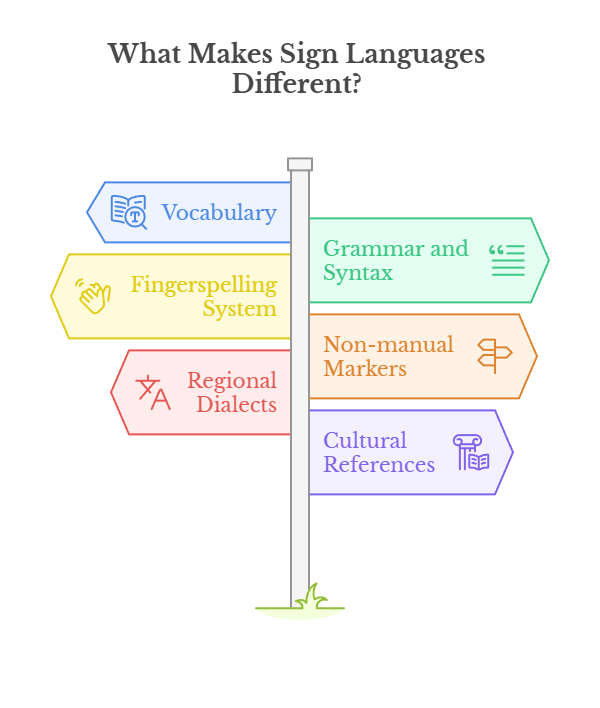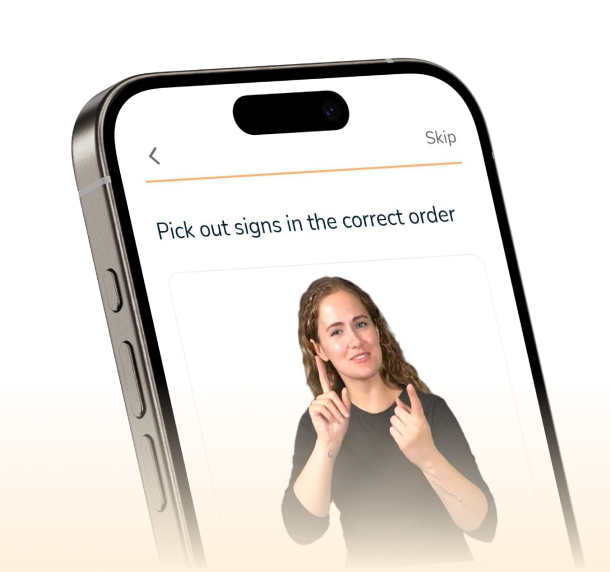What is the number of sign languages today?
Curious about the number of sign languages in the world? Learn how many exist worldwide and how different regions have developed unique visual languages.

There are over 300 different sign languages in use globally. This number isn't set in stone because new sign languages emerge and evolve all the time. Some sign languages are unique to specific regions and communities. Sign languages are not universal. Each sign language is distinct from the others. One great example is ASL and BSL.
Just like spoken languages, sign languages come in many forms. Each has its own rules, grammar, and culture.
You might think there is one universal sign language. But that's not the case.
Different countries, and sometimes even regions, have their own unique sign languages.
It's challenging to determine the exact number of sign languages today. Ongoing discoveries and evolving dialects make this task impossible.
But it is believed that there are over 300 sign languages in the world today.
Understanding their number and diversity is important. It helps break down barriers and encourages more inclusion for Deaf and hard-of-hearing people.
In this post, we'll talk about how many sign languages exist today and why they matter.
How many different sign languages are there?
Just like it's difficult to determine the number of spoken languages in the world, the same goes for sign language.
Current estimates generally agree that there are over 300 distinct sign languages in use globally.
Some are more widely used than others. For instance, American Sign Language (ASL) is used by 500,000 people in the US alone.
On the other hand, Auslan (Australian Sign Language) is used by 20,000 people.
Some sign languages are used by much smaller communities. This is the case for specific regions or even single villages.
We don't know the exact number of sign languages because of:
- Lack of data
- Regional variations
- New and emerging sign languages
- Limited recognition
- Debates over classification

Many sign languages are under-researched or undocumented. This often happens in smaller communities.
Some regions have distinct dialects or variations. These variations may or may not be classified as separate languages.
Another reason is new sign languages. They develop naturally within communities over time, adding to the count.
Some sign languages are not officially recognized by governments. This makes them harder to track.
Finally, there might be debates over their classification. Linguists sometimes disagree on whether certain sign systems are full languages or just dialects.
What is the most common sign language in the world?
The most used sign language in the world is Indo-Pakistani Sign Language (IPSL). It's used by at least 15 million Deaf signers.
Up to 6.3 million people who use it live in India, Pakistan, and Bangladesh.
This makes IPSL the most widely used sign language globally, surpassing other major sign languages.
Another sign language that is widely used is American Sign Language (ASL).
Around 500,000 people use ASL in the US. But its influence extends to other parts of the world.
This includes parts of West Africa, Southeast Asia, and other regions. It's so widespread due to historical ties and educational programs.
Other commonly used sign languages include:
- Chinese Sign Language (CSL)
- British Sign Language (BSL)
- French Sign Language (FLS)
- Brazilian Sign Language (Libras)
- Japanese Sign Language (JSL)
- Russian Sign Language (RSL)
- South African Sign Language (SASL)
- German Sign Language (DGS)
- Australian Sign Language (Auslan)
- Mexican Sign Language (LSM)
- Italian Sign Language (LIS)
Why is there no universal sign language?
Many people assume that sign language is universal. But that's simply not true.
Sign languages develop naturally within communities, just like spoken languages.
Every group of Deaf people creates its own way of signing to meet their needs. Over time, these signs grow into full languages with their own rules, grammar, and culture.
Geography plays a big part. People in different countries, and even different regions, don't always interact with each other.
This allows their sign languages to grow separately. For example, people in the US use American Sign Language (ASL), but people in the UK use British Sign Language (BSL).
Even though both countries speak English, ASL and BSL are very different languages.
History and culture also shape sign languages.
Communities develop signs for things that are important to them, like local foods, traditions, or events. This makes each sign language unique.
Because of these factors, there is no single, universal sign language. Instead, there are hundreds of different sign languages around the world.
Typical sign language differences
There are many differences between sign languages that make them unique or distinct.
Here are the most typical differences you'll find between various sign languages:
- Vocabulary
- Grammar and syntax
- Fingerspelling system
- Non-manual markers
- Regional dialects and variations
- Cultural references and idioms

The first aspect is vocabulary. Each sign language has its own set of signs for words and concepts.
For example, the sign for "dog" in ASL looks different from the same sign in BSL. Even everyday words like "hello" or "thank you" can vary between sign languages.
Sign languages have unique grammar rules that don't always mirror the spoken language of their country.
Of course, this will depend on the circumstances.
Many sign languages use fingerspelling to represent written letters. For example, names, technical terms, etc.
The manual alphabet differs widely. ASL uses a one-handed alphabet. BSL uses a two-handed alphabet.
Sign languages also require the use of non-manual markers (NMS). These include facial expressions, mouth shapes, and body movements.
Non-manual markers either change or add meaning.
The type and frequency of NMS can differ between sign languages. For example, in ASL, raising eyebrows often signals a yes/no question.
Just like spoken languages, sign languages can have regional dialects.
They also have cultural references and idioms. Some signs are rooted in cultural norms. So idioms or expressions may not translate across those sign languages.
Are there different types of ASL?
American Sign Language is its own complete sign language. While there are no "types"of ASL, there are different varieties, dialects, and specialized forms.
These variations include:
- Regional dialects
ASL differs across regions in the United States and Canada. Just like spoken English has accents and local slang, signs can vary depending on geography.
- Black ASL (BASL)
BASL is a distinct variety of ASL used within Black Deaf communities in the US. BASL features unique signs, a larger signing space, and different rhythmic patterns.
- Indigenous mixes
Some Native American communities blend tribal sign languages with ASL. Plains Indian Sign Language (PISL) is still used alongside ASL in some regions.
- Contact signing (Pidgin Signed English)
This is a blend of ASL and English word order. It's often used when Deaf and hearing people interact, especially with new ASL learners. It's not a formal language. But it's common in mixed environments like schools or casual conversations.
- Signed Exact English (SEE)
Signed Exact English (SEE) is not a dialect of ASL, but it's worth mentioning. SEE is designed to match English grammar exactly using signs. It's used in some educational settings, but not considered a natural language like ASL.
- Generational differences
Older and younger ASL users might use different signs or have different preferences.

Learn more about sign languages with ASL Bloom
If you're interested in exploring sign languages, ASL Bloom is a great place to start.
ASL Bloom is a user-friendly app designed to help you learn American Sign Language (ASL). It takes an engaging and interactive approach to learning ASL.
It doesn't matter if you're a complete beginner or looking to refresh your skills. ASL Bloom offers structured lessons that guide you through vocabulary, phrases, and grammar.
The app uses videos, quizzes, and real-life scenarios to make learning enjoyable. Plus, it's accessible anytime, so you can practice at your own pace.
Start your journey with ASL Bloom today. Build your confidence in communicating through sign language!
Start Learning ASL Today
Start your ASL learning journey today! Download the ASL Bloom app and take the first step toward learning American Sign Language.

Start Learning ASL Today
Start your ASL learning journey today! Download the ASL Bloom app and take the first step toward learning American Sign Language.
.webp)


.png)